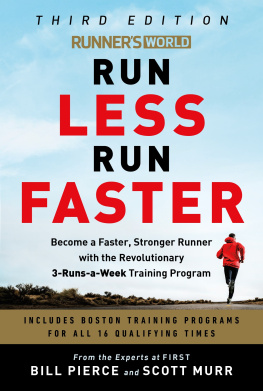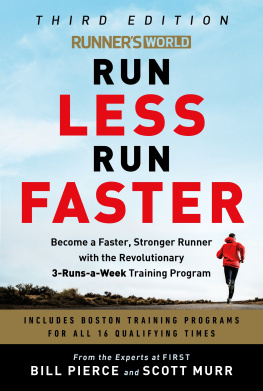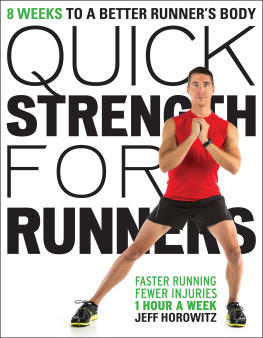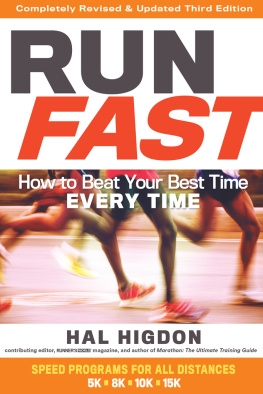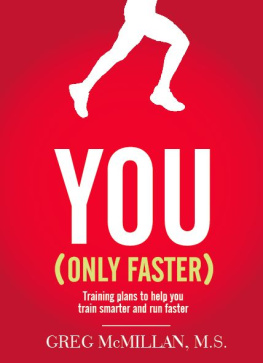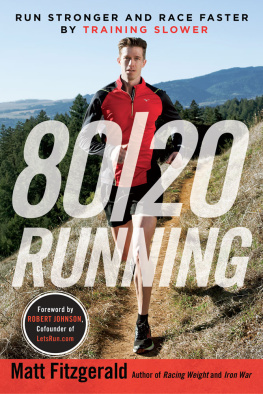

CONTENTS
S ECTION IV: S UPPLEMENTAL T RAINING
FOREWORD
I have long been a fan of the FIRST (Furman Institute of Running and Scientific Training) training program, and the dedicated people who created it (and continue to improve it). Still, after the first edition of Run Less, Run Faster was published, I started getting lots of questions from personal and email friends. In addition, I heard similar questions over and over again when I spoke at clinics and runners expos.
Does the FIRST training program work? How could it, given that it focuses primarily on just three workouts a week? Seems too easy to believe.
We runners are skeptical. We dont believe in free lunches, shoes guaranteed to prevent injuries, or foods that melt away the pounds.
We believe in a consistent, disciplined work ethic. We know thats the way to improve. How could the FIRST promise of fewer miles and workouts possibly succeed? Sounds shady.
I found the questions easy to answer. To begin, I told everyone, the FIRST program isnt easy. Just try a few of the workoutstheyre tough! Second, many runners fail to reach their running goals because they overtrainthey run too many mediocre workouts and not enough targeted workouts. As a result, theyre always tired but havent necessarily boosted their fitness and their racing potential. Thats where the FIRST approach shines.
Happily, Ive been able to convince a fair number of runners that less can be more. And almost invariably, the runners who tried the FIRST training program described in Run Less, Run Faster reported that it was a great success.
No, Im not going to exaggerate and say they all set personal records. Many did, but some didnt. However, even those who failed to get faster said they learned much about themselves and the best ways to train by following the program. They often recommended it to friends, which explains why Run Less, Run Faster has been one of Runners Worlds best-selling books for the past 5 years.
Now heres the new edition. Its got all the great workouts and schedules of the first edition, along with new findings Bill Pierce, Scott Murr, and Ray Moss have gleaned from countless email exchanges with FIRST training program users and from annual running camps they have organized each year at Furman University.
Below is the introduction to Run Less, Run Faster that I wrote 5 years ago. I feel even more positive about the program today than I did then, because now its been road-tested by literally thousands of runners.
Amby Burfoot
Editor-at-Large, Runners World
June 2011
Given the time-stressed lives that we lead, all runners have the same goal: to run the best we can with the limited amount of time at our disposal. After work, family, daily errands, and keeping up with piles of laundry, how ya gonna fit in enough good workouts to reach your goals? Its the biggest running challenge we face. And Bill Pierce, Scott Murr, and Ray Moss have the answer with the FIRST training program. I know no other training system that comes close to providing the proven, efficient one youll discover in this book.
But I dont want you to think that the FIRST training program is easy. It isnt. I learned this the hard way a couple of Aprils ago when I visited Bill and his colleagues at Furman University in Greenville, South Carolina, and spent several days training with them. In particular, I ran with Bill and his brother, Don. We learned that were all about the same age and ability level over a low-fat Italian dinner on my first night in town. The next day, we ran one of Bills favorite interval workouts, 5 x 1000 meters on a gorgeous curving path along a tree-lined lake on the Furman campus. We warmed up with a relaxed mile or two, and then began the 1000-meter repeats, I thought I was in good shape at the time, but it took all my resolve to match strides with Bill. While I wouldnt say I was running 100 percent, I certainly wasnt lollygagging. Call it a 98 percent effort. I was pooped.
Fortunately, the FIRST method conceived by the team of professors and coaches at the Furman Institute of Running and Scientific Training (FIRST) provides plenty of recovery between hard efforts. I was happy to take the next day off and simply stroll around campus for 30 minutes. Bill played tennis.
That brought us to Day Three, a tempo training day. After another several-mile warmup, Bill and Scott took off on a steady 4-mile run that was supposed to be hard but controlled. For them, I think it was. For me, however, it was too much. I lagged about 30 seconds behind Bill, wondering how he could run hard again just 48 hours after our 1000-meter repeats. The obvious answer: Hes been training this way for nearly 20 years. He has adapted to the FIRST program and gotten stronger and faster with it. I hadnt been following the FIRST program though it didnt take me long to decide that I should. Who doesnt want the most fuel-efficient car, or mortgage with the lowest interest rate, or the runners training program that provides the best results in the least amount of time? I most appreciate that the FIRST approach is scientifically based and meticulously measured. Many coaches and personal trainers develop their plans according to their proven successes. Unfortunately, theyve got no scientific or statistical analysis to back up their claims. They might be good enough coaches, but theyve never actually studied how well their plans work.
Bill, Ray, and Scott haveextensively.
The members of the FIRST team were college professors before they became coaches and have always approached the FIRST system as a scientific experiment. Theyve measured all their runners before and after beginning the FIRST program, and the results could very well have proven the system an absolute bust. But thats not what happened. Instead, the experiments have produced consistently spectacular outcomes. The runners train less than they used to, and 16 weeks later theyre running faster.
It sounds like snake oil, but it isnt. Just ask Bill for a peek into his bulging folder of thank-you letters and emails. A runners success can never be guaranteed. Life happens to us allwe have to change jobs, we get injured, were waylaid by a family health crisis the list goes on and on. But the FIRST training program is more closely studied and more guaranteed than any other running program I have ever seen. Whats more, youll spend less time training than you are right now. Youve got nothing to lose. Its a win-win program that has worked for hundreds of other runners, and theres no reason it cant work for you.
PREFACE
The first edition of Run Less, Run Faster elicited an overwhelming response: More than 7,500 messages from runners on six continents provided us with valuable feedback to the FIRST (Furman Institute of Running and Scientific Training) training programs. The daily messages from around the globe have given us insight into the challenges runners face whether theyre training in the sweltering Philippines or South Florida, in subzero, snow-covered Canada or Scandinavia, in the desert sandstorms of Iraq, or on an oscillating ship in the Persian Gulf. Others have needed to deal with living in a town with no running track or traveling on business with access only to a hotel treadmill. Equally daunting are the problems that face a mother of five who must train between 4:00 and 5:30 a.m. or a second-shift worker who begins training at midnight. Many have special medical problems; others describe how professional obligations have left them sedentary for years and others want to know how to begin or enhance their training. Runners faced with all of these special challenges have sought advice from us on how to use the FIRST training program effectively.
Next page

